Gas Separation Membrane Market by Module, Material Type, Application (Nitrogen Generation & Oxygen Enrichment, Hydrogen Recovery, CDR, Vapor/Gas Separation, Vapor/Vapor Separation, Air Dehydration, H2S Removal), and Region - Global Forecast to 2030
Updated on : June 14, 2024
Gas Separation Membrane Market
The global gas separation membrane market was valued at USD 1.0 billion in 2023 and is projected to reach USD 1.6 billion by 2030, growing at 7.4% cagr from 2023 to 2030. The market is projected to grow significantly in the coming years. Gas separation membranes present a more energy-efficient option compared to conventional separation techniques such as cryogenic distillation or chemical absorption. With energy efficiency emerging as a top priority, there is a rising demand for these membranes.
Global Gas Separation Membrane Market Trend
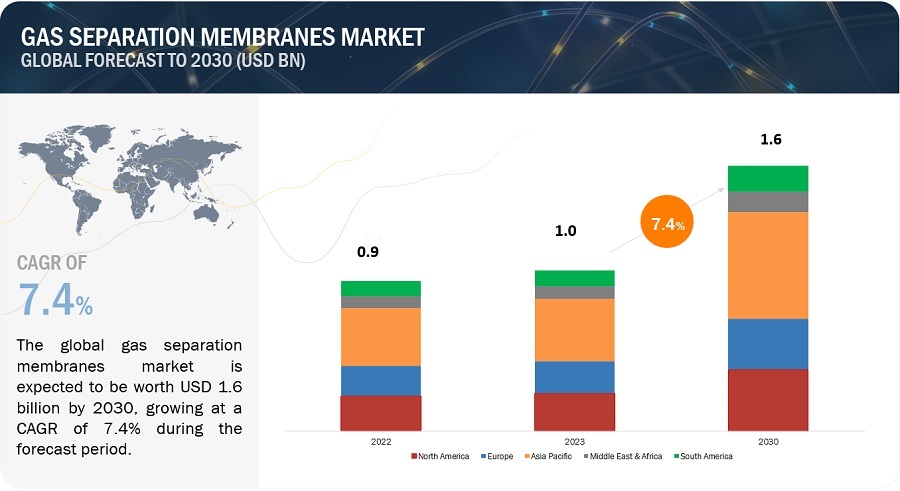
To know about the assumptions considered for the study, Request for Free Sample Report
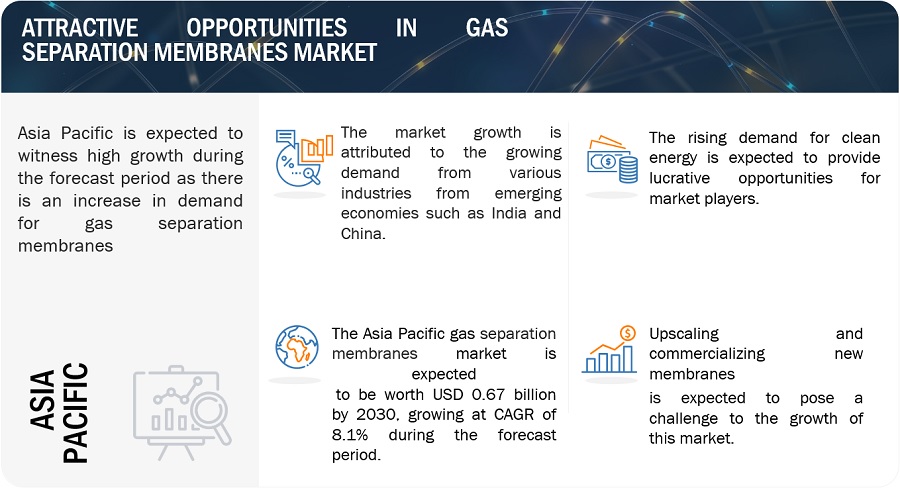
Gas Separation Membrane Market Dynamics
Driver: Environmental regulations and stringent emission standards
Environmental regulations, enforced by governmental bodies, are designed to safeguard the environment, human health, and public welfare by establishing standards, guidelines, and limitations for various industries and activities. These regulations aim to mitigate the impact of industrial operations on the environment by controlling the emission of pollutants such as greenhouse gases (GHGs), sulfur dioxide (SO2), and nitrogen oxides (NOx). Gas separation membranes play a crucial role in adhering to these regulations, particularly in carbon capture and storage (CCS) applications. Here, they selectively capture and separate CO2 emissions from flue gases, aiding industries in meeting emission reduction targets and regulatory compliance. Gas separation membranes enable industries to fulfill stringent environmental standards while preserving or even improving operational efficiency. Their ability to selectively separate specific gases and contaminants minimizes waste generation and reduces energy consumption, contributing to environmental sustainability.
Restraint: Plasticization of polymeric membranes in high-temperature applications
Plasticization of polymer membranes in high-temperature settings occurs when the polymer material becomes more flexible and less discerning under elevated temperatures. This phenomenon results from thermal energy disrupting the molecular structure of the polymer, facilitating easier diffusion of gas molecules through the membrane. Consequently, the membrane's ability to selectively separate specific gases diminish, compromising its overall performance in gas separation. This plasticization effect is a crucial factor to consider when developing polymer-based gas separation membranes for applications in high-temperature environments, such as those found in natural gas processing or various industrial processes. It can significantly impact the membrane's long-term stability and effectiveness. To address plasticization, researchers often explore advanced polymer materials characterized by higher glass transition temperatures. Additionally, hybrid membranes incorporating inorganic components are investigated to preserve membrane integrity and selectivity under extreme temperature conditions.
Opportunity: Rising demand for clean energy
The increasing global demand for clean energy arises from mounting concerns regarding climate change, environmental deterioration, and air quality. Societies worldwide are progressively adopting renewable energy sources such as solar, wind, and hydroelectric power, alongside advancements in nuclear and energy storage technologies. This transition reflects a commitment to reducing greenhouse gas emissions, enhancing energy security, and promoting economic growth through sustainable practices. Governments, industries, and individuals are increasingly acknowledging the potential of clean energy not only to mitigate the impacts of climate change but also to create employment opportunities, improve public health, and diversify energy portfolios. This collective effort is paving the way towards a more sustainable and resilient future.
Challenges: Upscaling and commercializing new membranes
Scaling up and bringing new gas separation membranes to the commercial market presents notable hurdles in the field. Despite ongoing research yielding promising outcomes on a laboratory scale, translating these advancements into large-scale industrial settings proves intricate. Challenges encompass assuring the durability and resilience of membranes in real-world scenarios, sustaining cost-efficiency during scaling, and tackling fouling and maintenance concerns. Additionally, the diversity in feedstock gases and operational parameters across various industries amplifies the complexity. Successful commercialization demands significant investments, collaborative efforts between researchers and industry stakeholders, and meticulous testing to adhere to rigorous performance benchmarks and regulatory requirements.
Gas Separation Membrane Market Ecosystem
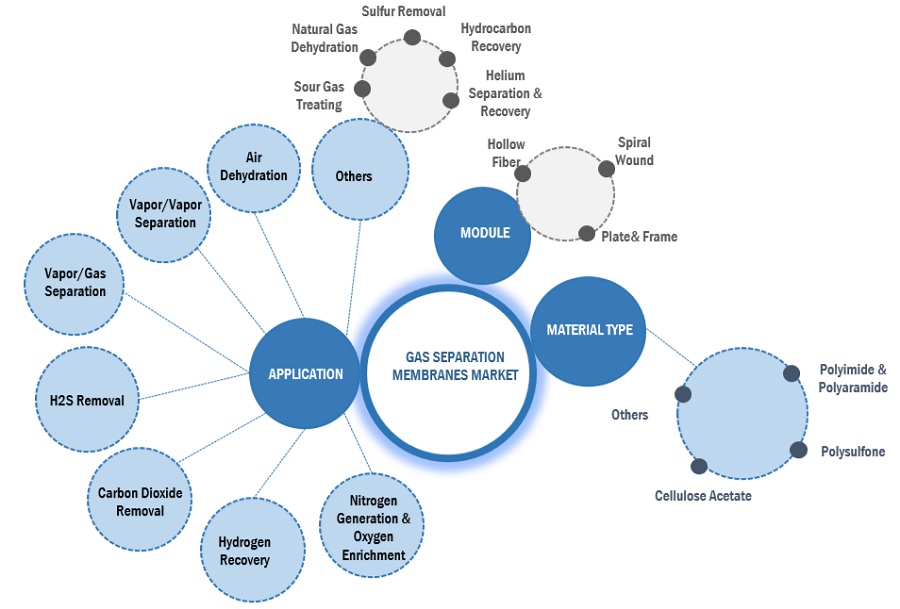
By material type, polysulfone is the second fastest growing in gas separation membrane market, in 2022.
Polysulfone is an organic polymer widely employed in gas separation applications, offering remarkable chemical and thermal stability to membranes. Its resistance to mineral acids, alkalis, electrolytes, and oxidizing agents makes it a preferred choice. It is renowned for its exceptional chemical resistance and thermal stability, polysulfone exhibits robust mechanical properties, including high compaction resistance, even under elevated pressures. This polymer can be cast or fabricated into thin film structures suitable for gas separation processes. Leveraging its inherent properties, polysulfone forms a selective barrier that allows specific gases to pass through based on their size, shape, and solubility characteristics. Its widespread use in gas separation applications is attributed to its cost-effectiveness and desirable attributes, such as high rigidity, creep resistance, strength, and a high heat deflection temperature.
By module, plate and frame module is the largest in gas separation membrane market, in 2022.
The plate and frame module is rapidly gaining prominence as the leading technology for gas separation, owing to its versatility and effectiveness. This innovative module design comprises stacked plates and frames, providing a substantial surface area conducive to efficient gas separation methods like membrane filtration and adsorption. Its compact size and scalability render it suitable for diverse applications, spanning industrial gas purification to greenhouse gas capture and natural gas processing. Additionally, the modular structure of the plate and frame module facilitates seamless customization and integration into existing gas separation systems, offering a cost-efficient and environmentally sustainable solution to meet the increasing need for advanced gas separation technologies.
By application, vapor / gas separation segment is the second fastest growing application in the gas separation membrane market, in 2022.
The vapor/gas separation application is witnessing rapid expansion within the gas separation membrane market, driven by its efficacy in addressing diverse industry challenges. This technology entails the separation of various vapor components from gas mixtures, finding wide-ranging utility across sectors such as petrochemicals, natural gas processing, and environmental preservation. Its growth can be attributed to its capacity for delivering high-purity separations while consuming less energy compared to traditional gas separation methods. As industries increasingly prioritize environmental sustainability and stringent quality standards, vapor/gas separation emerges as a pivotal solution to meet these demands, leading to its swift adoption and proliferation within the gas separation sector.
Asia Pacific accounted for the largest market share in the gas separation membrane market, in terms of value.
The gas separation membrane sector in the Asia-Pacific region is undergoing significant growth and development. This expansion is fueled by various factors, including the region's booming industrial domains, heightened emphasis on environmental sustainability, and increasing need for clean energy alternatives. Gas separation membranes, utilized in diverse applications like nitrogen generation, carbon capture, and natural gas processing, are gaining traction owing to their energy-efficient nature and cost-effectiveness. Furthermore, governmental efforts targeting greenhouse gas reduction are driving the uptake of gas separation membranes, positioning the Asia-Pacific market as a hub for the advancement and implementation of these innovative technologies.
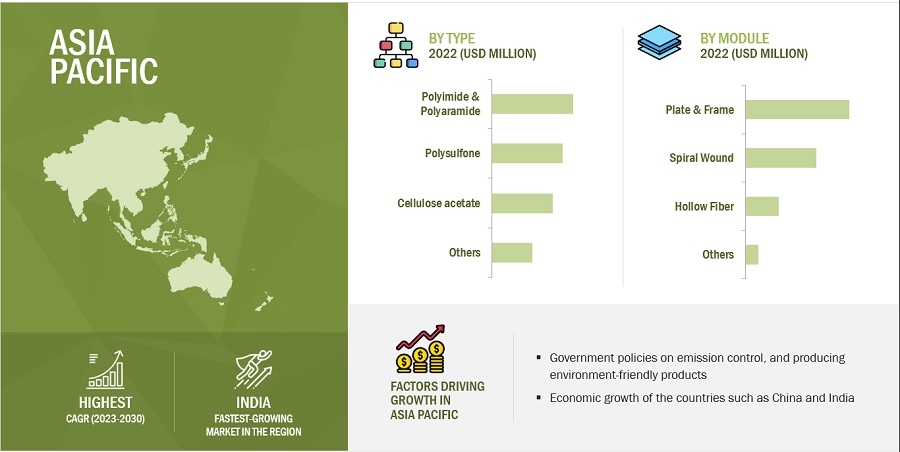
To know about the assumptions considered for the study, download the pdf brochure
Gas Separation Membrane Market Players
Some of the key players operating in the gas separation membrane market include Air Liquide (France), Air Products and Chemicals, Inc. (US), UBE Corporation (Japan), Honeywell UOP (US), FUJIFILM Manufacturing Europe B.V. (Netherlands), SLB (US), DIC Corporation (Japan), PARKER HANNIFIN CORPORATION (US), Membrane Technology and Research, Inc. (US), and Generon (US) among others.
These companies have adopted various organic as well as inorganic growth strategies between 2019 and 2023 to strengthen their positions in the market. The new product launch is the key growth strategy adopted by these leading players to enhance regional presence and develop product portfolios to meet the growing demand for gas separation membrane from emerging economies.
Read More: Gas Separation Membrane Companies
Gas Separation Membrane Market Report Scope
|
Report Metric |
Details |
|
Years considered for the study |
2019-2030 |
|
Base Year |
2022 |
|
Forecast period |
2023–2030 |
|
Units considered |
Value (USD Million), Volume (Million Square Meter) |
|
Segments |
Material Type, Module, Application, and Region |
|
Regions |
Asia Pacific, North America, Europe, Middle East & Africa, and South America |
|
Companies |
Air Liquide (France), Air Products and Chemicals, Inc. (US), UBE Corporation. (Japan), Honeywell UOP (US), FUJIFILM Manufacturing Europe B.V. (Netherlands), SLB (US), DIC Corporation (Japan), PARKER HANNIFIN CORPORATION (US), Membrane Technology and Research, Inc. (US), and Generon (US) among others. |
This report categorizes the global gas separation membrane market based on type, module, application, and region.
On the basis of material type, the gas separation membrane market has been segmented as follows:
- Polyimide & Polyaramide
- Polysulfone
- Cellulose acetate
- Others
On the basis of module, the gas separation membrane market has been segmented as follows:
- Spiral wound
- Hollow fiber
- Plate & Frame
- Others
On the basis of application, the gas separation membrane market has been segmented as follows:
- Nitrogen Generation & Oxygen Enrichment
- Hydrogen Recovery
- Carbon Dioxide Removal
- Vapor/Gas Separation
- Vapor/Vapor Separation
- Air Dehydration
- H2S Removal
- Others
On the basis of region, the gas separation membrane market has been segmented as follows:
- North America
- Asia Pacific
- Europe
- South America
- Middle East & Africa
The gas separation membrane market has been further analyzed based on key countries in each of these regions.
Recent Developments
- In September 2023, Membrane Technology and Research, Inc. has expanded its business by building the largest membrane-based carbon capture plant in Gillette, Wyoming. This expansion will help the company to use Polaris polymeric membrane to capture more than 150 tonnes of CO2 each day.
- In June 2022, FUJIFILM Manufacturing Europe B.V. has expanded membrane production at its manufacturing plant in Tilburg, the Netherlands, with a focus on sustainability. The facility integrates initiatives aimed at achieving CO2-neutral status and employs sustainable technologies for wastewater purification. This expansion helped the company to strengthen membrane production capacity and address rising product demand.
- In October 2021, Air Products announced a new brand identity for its membrane business units, which will now all operate around the world as Air Products Membrane Solutions. The new identity moves the former business units, including Air Products PRISM Membranes, Air Products Norway, and Permea China Ltd., under one name to simplify the customer experience and further encourage collaboration and innovations.
- In November 2021, Honeywell announced collaboration with SK Innovation and Energy, a Korea-based energy refining company, for a feasibility study to retrofit SK's hydrogen plant with carbon capture. SK Innovation and Energy is expected to explore capturing and sequestering 400,000 tons of carbon dioxide (CO2) from existing hydrogen production facilities. Honeywell UOP has multiple technology offerings such as solvents, membranes, cryogenics, and pressure swing adsorption (PSA) systems that can be optimized to meet the project requirements.
Frequently Asked Questions (FAQ):
What is the current market size of the global gas separation membrane market?
Global gas separation membrane market size is estimated to reach USD 1.6 billion by 2030 from USD 1.0 billion in 2023, at a CAGR of 7.4% during the forecast period.
Who are the winners in the global gas separation membrane market?
Companies such as include Air Liquide (France), Air Products and Chemicals, Inc. (US), UBE Corporation. (Japan), Honeywell UOP (US), FUJIFILM Manufacturing Europe B.V. (Netherlands), SLB (US), DIC Corporation (Japan), PARKER HANNIFIN CORPORATION (US), Membrane Technology and Research, Inc. (US), and Generon (US) among others. They have the potential to broaden their product portfolio and compete with other key market players.
What are some of the drivers in the market?
Growing demand in nitrogen generation and syngas cleaning, Increasing demand for membranes in carbon dioxide separation processes technology, and Environmental regulations and stringent emission standards.
What are the various material types of gas separation membranes?
Polyimide & polyaramide, Polysulfone, and Cellulose acetate are the major types of gas separation membranes.
What are the applications of gas separation membranes?
Nitrogen generation & oxygen enrichment, hydrogen recovery, carbon dioxide removal, vapor/gas separation, vapor/vapor separation, air dehydration, and H2S removal are the main applications of gas separation membranes. .
To speak to our analyst for a discussion on the above findings, click Speak to Analyst
The study involved four major activities in estimating the current market size for gas separation membranes. Exhaustive secondary research was conducted to collect information on the market, peer market, and parent market. The next step was to validate these findings, assumptions, and sizing with industry experts across the value chain through primary research. Both top-down and bottom-up approaches were employed to estimate the complete market size. After that, the market breakdown and data triangulation methodologies were used to estimate the market size of segments and subsegments.
Secondary Research
In the secondary research process, various secondary sources such as Factiva, Zauba, Hoovers, and Bloomberg BusinessWeek were referred to for identifying and collecting information for this study. These secondary sources included annual reports, press releases & investor presentations of companies, white papers, certified publications, articles by recognized authors, regulatory bodies, and databases.
Secondary research has been used to obtain key information about the value chain of the industry, monetary chain of the market, the total pool of key players, market classification and segmentation according to industry trends to the bottom-most level, and regional markets. It was also used to obtain information about the key developments from a market-oriented perspective.
Primary Research
The gas separation membrane market comprises several stakeholders, such as membrane suppliers, distributors of gas separation membranes, system manufacturers, and regulatory organizations in the supply chain. The demand side of this market consists of applications such as hydrogen recovery, nitrogen generation & oxygen enrichment and carbon dioxide removal. Various primary sources from both the supply and demand sides of the market were interviewed to obtain qualitative and quantitative information.
Primary interviews were conducted to gather insights such as market statistics, data of revenue collected from the products and services, market breakdowns, market size estimations, market forecasting, and data triangulation. Primary research also helped in understanding the various trends related to this market. Stakeholders from the demand side, such as CIOs, CTOs, and CSOs were interviewed to understand the buyer’s perspective on the suppliers, products, component providers, and their current usage of gas separation membranes and future outlook of their business which will affect the overall market.
Following is the breakdown of primary respondents.
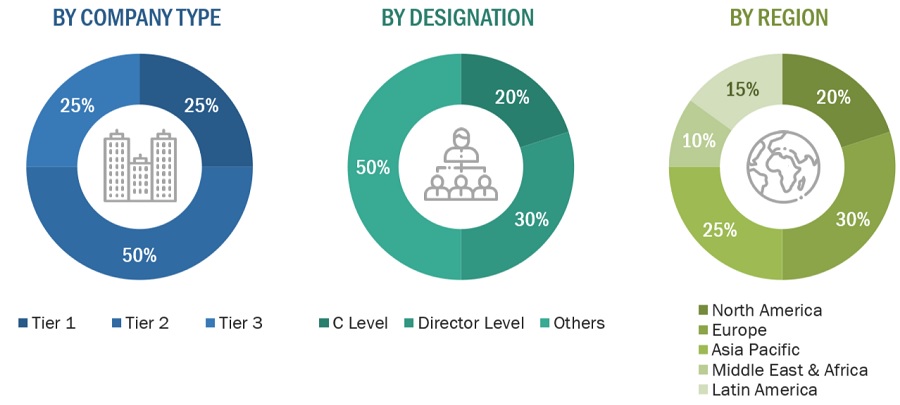
To know about the assumptions considered for the study, download the pdf brochure
Market Size Estimation
Both top-down and bottom-up approaches were used to estimate and validate the total size of the gas separation membrane market. These methods were also used extensively to determine the size of various subsegments in the market. The research methodology used to estimate the market size includes the following:
- The key players in the industry and markets were identified through extensive secondary research.
- The industry’s supply chain and market size, in terms of value and volume, were determined through primary and secondary research processes.
- All percentage shares, splits, and breakdowns were determined using secondary sources and verified through primary sources.
Gas Separation Membrane Market: Bottum-Up Approach

Note: All the shares are based on the global market size.
Source: Secondary Research, Interviews with Experts, and MarketsandMarkets Analysis
To know about the assumptions considered for the study, Request for Free Sample Report
Gas Separation Membrane Market: Top-Down Approach

Source: Secondary Research, Interviews with Experts, and MarketsandMarkets Analysis
Data Triangulation
After arriving at the overall market size—using the market size estimation process explained above—the market was split into several segments and sub-segments. To complete the overall market engineering process and arrive at the exact statistics of each market segment and subsegment, data triangulation, and market breakdown procedures were employed, wherever applicable. The data was triangulated by studying several factors and trends from both the demand and supply of gas separation membranes and their applications.
Market Definition
A gas separation membrane is a specialized substance designed to separate gases selectively according to their molecular characteristics, including size, shape, or chemical affinity. These membranes find application across various industrial sectors for the purpose of separating, purifying, or concentrating specific gases within gas mixtures. The fundamental operating principle of gas separation membranes revolves around permeation, whereby gases permeate through the membrane at varying rates, enabling the isolation of desired gases from the mixture.
Gas separation membranes have broad applications across numerous industries owing to their capacity for selectively isolating gases from complex mixtures. In renewable energy, these membranes are instrumental in biogas upgrading, where they extract and eliminate carbon dioxide and hydrogen sulfide from biogas derived from organic waste, yielding high-purity methane for energy production. Furthermore, they play a critical role in carbon capture and storage (CCS) endeavors aimed at mitigating greenhouse gas emissions by selectively capturing and separating carbon dioxide from flue gases emitted by power plants and industrial facilities. These versatile membranes also find utility in hydrogen production, nitrogen generation, and various industrial processes requiring efficient gas separation to enhance product quality, process efficiency, and minimize environmental impact.
Key Stakeholders
- Senior Management
- End User
- Finance/Procurement Department
- R&D Department
Objectives of the Study:
- To define, describe, and forecast the gas separation membrane market, in terms of value and volume.
- To provide detailed information about the key factors (drivers, restraints, opportunities, and challenges) influencing the market growth
- To analyze and forecast the market by material type, module, and application.
- To forecast the size of the market for five regions, namely, Asia Pacific, Europe, North America, South America, and the Middle East & Africa along with their key countries
- To strategically analyze micromarkets with respect to individual growth trends, prospects, and contributions to the total market
- To analyze the opportunities in the market for stakeholders and provide a competitive landscape for market leaders.
- To analyze competitive developments, such as new product launches, acquisitions, and expansion undertaken in the market
- To strategically profile key players and comprehensively analyze their market ranking and core competencies.
Available Customizations
With the given market data, MarketsandMarkets offers customizations according to the specific requirements of companies. The following customization options are available for the report:
Regional Analysis:
- Country-level analysis of the gas separation membrane market
Company Information:
- Detailed analysis and profiling of additional market players



 Generating Response ...
Generating Response ...







Growth opportunities and latent adjacency in Gas Separation Membrane Market
Research required on utilization of contaminated natural gas sources by using energy-consumed membrane technology
Gas separation membranes for nitrogen generation of the London and oxygen and oxygen generation.